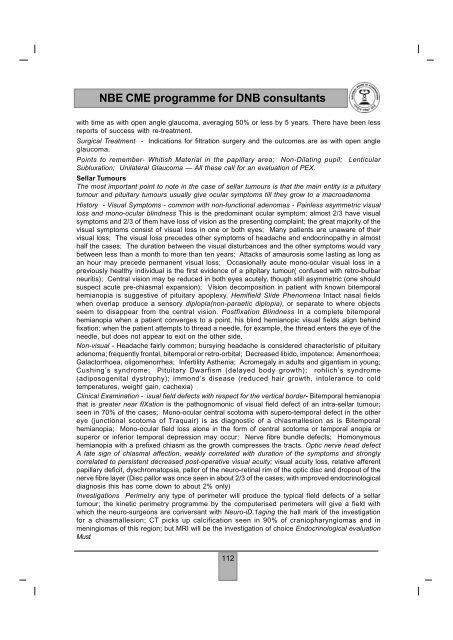NBE CME programme for DNB consultants - National Board Of ...
NBE CME programme for DNB consultants - National Board Of ...
NBE CME programme for DNB consultants - National Board Of ...
Create successful ePaper yourself
Turn your PDF publications into a flip-book with our unique Google optimized e-Paper software.
<strong>NBE</strong> <strong>CME</strong> <strong>programme</strong> <strong>for</strong> <strong>DNB</strong> <strong>consultants</strong>with time as with open angle glaucoma, averaging 50% or less by 5 years. There have been lessreports of success with re-treatment.Surgical Treatment - Indications <strong>for</strong> filtration surgery and the outcomes are as with open angleglaucoma.Points to remember- Whitish Material in the papillary area; Non-Dilating pupil; LenticularSubluxation; Unilateral Glaucoma — All these call <strong>for</strong> an evaluation of PEX.Sellar TumoursThe most important point to note in the case of sellar tumours is that the main entity is a pituitarytumour and pituitary tumours usually give ocular symptoms till they grow to a macroadenomaHistory - Visual Symptoms - common with non-functional adenomas - Painless asymmetric visualloss and mono-ocular blindness This is the predominant ocular symptom; almost 2/3 have visualsymptoms and 2/3 of them have loss of vision as the presenting complaint; the great majority of thevisual symptoms consist of visual loss in one or both eyes; Many patients are unaware of theirvisual loss; The visual loss precedes other symptoms of headache and endocrinopathy in almosthalf the cases; The duration between the visual disturbances and the other symptoms would varybetween less than a month to more than ten years; Attacks of amaurosis some lasting as long asan hour may precede permanent visual loss; Occasionally acute mono-ocular visual loss in apreviously healthy individual is the first evidence of a pitpitary tumour( confused with retro-bulbarneuritis); Central vision may be reduced in both eyes acutely, though still asymmetric (one shouldsuspect acute pre-chiasmal expansion); Vision decomposition in patient with known bitemporalhemianopia is suggestive of pituitary apoplexy. Hemifield Slide Phenomena Intact nasal fieldswhen overlap produce a sensory diplopia(non-paraetic diplopia), or separate to where objectsseem to disappear from the central vision. Postfixation Blindness In a complete bitemporalhemianopia when a patient converges to a point, his blind hemianopic visual fields align behindfixation; when the patient attempts to thread a needle, <strong>for</strong> example, the thread enters the eye of theneedle, but does not appear to exit on the other side.Non-visual - Headache fairly common; bursying headache is considered characteristic of pituitaryadenoma; frequently frontal, bitemporal or retro-orbital; Decreased libido, impotence; Amenorrhoea;Galactorrhoea, oligomenorrhea; Infertility Asthenia; Acromegaly in adults and gigantism in young;Cushing’s syndrome; Pituitary Dwarfism (delayed body growth); rohlich’s syndrome(adiposogenital dystrophy); immond’s disease (reduced hair growth, intolerance to coldtemperatures, weight gain, cachexia)Clinical Examination - isual field defects with respect <strong>for</strong> the vertical border- Bitemporal hemianopiathat is greater near fIXation is the pathognomonic of visual field defect of an intra-sellar tumour;seen in 70% of the cases; Mono-ocular central scotoma with supero-temporal defect in the othereye (junctional scotoma of Traquair) is as diagnostic of a chiasmallesion as is Bitemporalhemianopia; Mono-ocular field loss alone in the <strong>for</strong>m of central scotoma or temporal anopia orsuperor or inferior temporal depression may occur; Nerve fibre bundle defects; Homonymoushemianopia with a prefixed chiasm as the growth compresses the tracts. Optic nerve head defectA late sign of chiasmal affection, weakly correlated with duration of the symptoms and stronglycorrelated to persistent decreased post-operative visual acuity; visual acuity loss, relative afferentpapillary deficit, dyschromatopsia, pallor of the neuro-retinal rim of the optic disc and dropout of thenerve fibre layer (Disc pallor was once seen in about 2/3 of the cases; with improved endocrinologicaldiagnosis this has come down to about 2% only)Investigations Perimetry any type of perimeter will produce the typical field defects of a sellartumour; the kinetic perimetry <strong>programme</strong> by the computerised perimeters will give a field withwhich the neuro-surgeons are conversant with Neuro-iD.1aging the hall mark of the investigation<strong>for</strong> a chiasmallesion; CT picks up calcification seen in 90% of craniopharyngiomas and inmeningiomas of this region; but MRI will be the investigation of choice Endocrinological evaluationMust112
















